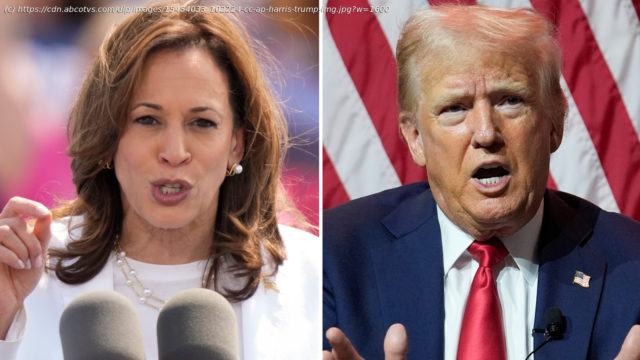In the United States, we elect our president and vice president using the Electoral College rather than the national popular vote.
In the United States, we elect our president and vice president using the Electoral College rather than the national popular vote. To win, a party’s ticket must win the most votes in enough states to attain an outright majority of electoral votes – at least 270 votes out of a total of 538 (sound familiar?).
But lurking in that overall figure is the potential for no candidate to win a majority, in the case of a 269-to-269 tie. While seemingly not in play in the 2024 election, it’s also possible that third parties could win sufficient electoral votes to prevent anyone from hitting 270. Regardless of how it happens, should no contender claim a majority, the Constitution calls for Congress to carry out the selection of our national executives via a « contingent election. » In this scenario, the U.S. House of Representatives would choose the president, although based not on the vote of the whole chamber but each state’s preferences – meaning a candidate needs majority support from 26 state delegations out of 50 to win – and the 100-seat U.S. Senate would pick the vice president based on the vote of individual senators, with 51 votes needed to win.
Could we run into this situation in the 2024 presidential race? It’s possible, though pretty unlikely: According to 538’s presidential forecast, there’s only about a 1-in-300 chance that neither Vice President Kamala Harris or former President Donald Trump attain 270 electoral votes, and the only plausible scenarios here involve a 269-269 tie in which key swing states shift in ways that appear less likely based on the current state of the race. With that in mind, let’s take a look at how we could end up with contingent elections for president and vice president, and why such a development would heavily favor Republicans.
How Harris and Trump could both end up shy of 270
Of the small number of scenarios in 538’s presidential forecast in which Harris and Trump tie, four scenarios are by far the most plausible, making up about 4 in 5 of those rare cases. In each, Harris would capture states and congressional districts worth 225 electoral votes, while Trump would capture 219. That leaves the 94 electoral votes in the seven principal battleground states – Arizona, Georgia, Michigan, Nevada, North Carolina, Pennsylvania and Wisconsin – as well as Nebraska’s 2nd District in play for a possible tie, with the outcomes in those contests varying across all four cases, as shown in the table below.
The four most likely scenarios for a 269-269 Electoral College tie
The four most likely sets of election outcomes in the seven key swing states and Nebraska’s 2nd Congressional District that would produce a 269-269 tie in the Electoral College, according to 538’s presidential forecast as of 8:30 a.m. on Oct. 21
Three of these four scenarios involve at least two of the three northern swing states shifting into the GOP column while the southern and western ones mostly end up in Democratic hands. That is somewhat at odds with our current forecast, which gives Trump a slightly better chance of flipping states in the Sun Belt than in the Frost Belt.
Of these, Scenario 1 is the most common – only with about a 1-in-1,000 shot of happening, however – and involves Trump holding onto North Carolina and flipping Pennsylvania and Michigan, while Harris retains Wisconsin, Arizona, Georgia and Nevada from President Biden’s 2020 showing. Next-most common is Scenario 2 (about a 1-in-1,200 shot), which includes mostly the same results, except with Harris and Trump trading Georgia and North Carolina’s identical electoral votes. Scenario 3, has about a 1-in-1,600 shot of happening – In it, Trump reclaims the Sun Belt states and Nebraska’s 2nd District while Harris holds onto the three northern battlegrounds. Scenario 4 is the least likely of this quartet (about a 1-in-2,000 chance), but it involves Trump carrying all the northern battlegrounds and Nevada while Harris wins the three southern swing states.
Beyond these scenarios, a handful of even more remote possibilities exist, but they have about a 1-in-10,000 (or worse) chance of occurring. Of those, the only ones that happen at least twice in our forecast’s roughly 34,000 simulations are four sets of state-by-state results in which Democratic-leaning New Hampshire or Virginia go Republican, while the outcomes in the seven key swing states vary (although Michigan remains in the Democratic column in all four). Out of the 12 other simulations that produce a tie, two involve Maine’s red-leaning 2nd District going Democratic.
Now, 538’s forecast assumes that electoral votes will go to the candidate who has won them based on the election results – but that’s not a 100-percent given. In 2020, for instance, Republicans in a handful of states that voted for Biden attempted to submit fake Republican electors to Congress in support of Trump’s unfounded claims that he’d actually won the election. And about two-thirds of House Republicans voted against certifying the results in one or both of Arizona and Pennsylvania. While these attempts to disrupt the 2020 election ultimately failed, they could definitely come into play in 2024, too.
Additionally, the electors of the Electoral College have some room for maneuver to cast votes for whomever they want, meaning a « faithless elector » could refuse to cast their vote for the ticket they were expected to support. For instance, in 2016, five Democratic electors and two Republican electors did not cast their votes for their party tickets but instead voted for other candidates.






